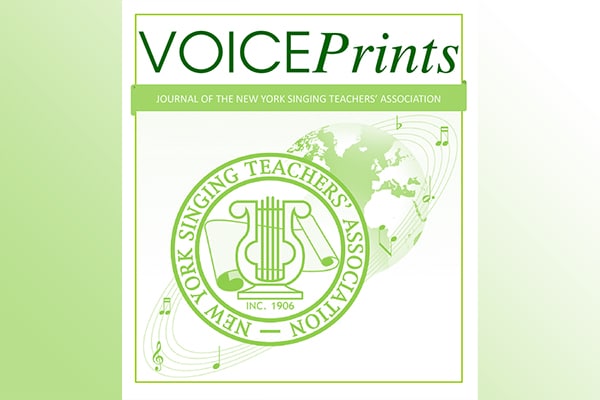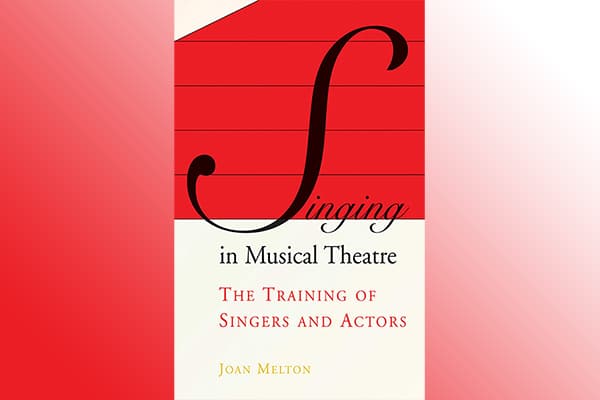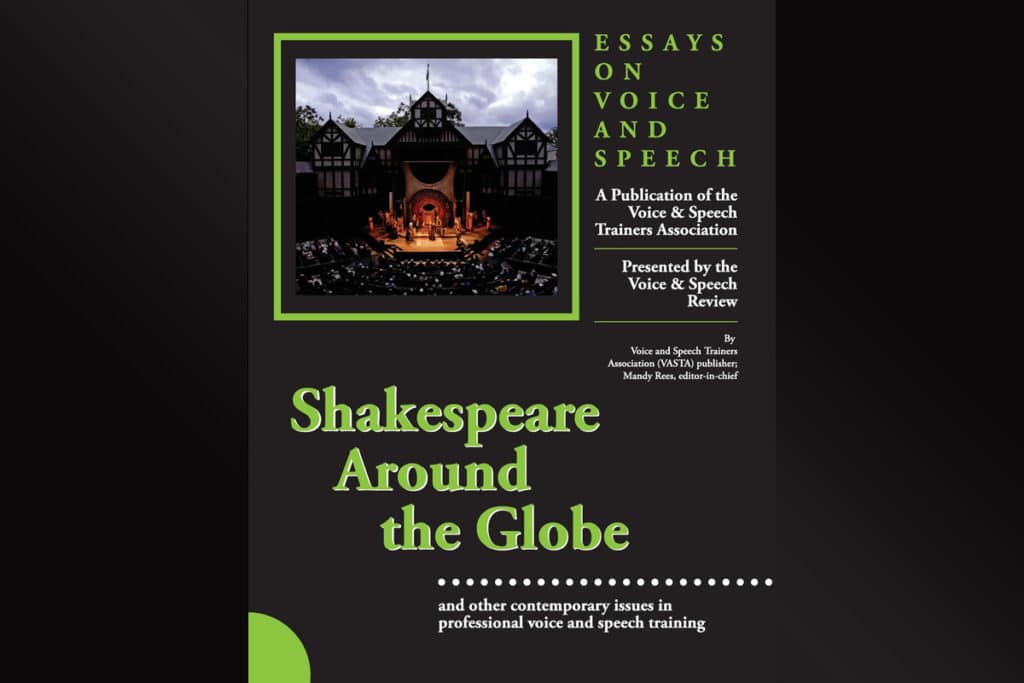
From NYSTA VOICEPrints
Journal of the New York Singing Teachers’ Association
March–April, 2013
I am on my way to a conference of the National Association of Teachers of Singing (NATS) when my telephone starts flooding with excited texts. One of our recent graduates has been told to suit up for the matinee performance as Elphaba in Wicked on Broadway! I sit back and smile thinking of this young girl as a freshman and of how much skill, poise, and confidence she has acquired in a few short years. Then I think, what a wonderful job I have.
It is March 2012 and Penn State has just completed the last of its auditions for admission to its BFA in musical theater. Approximately five hundred high school seniors have been seen on campus, in New York, Chicago, Houston and Los Angeles for fourteen slots in the incoming freshman class. Every year since I arrived on campus in 1999, the preparation and training needed to qualify for acceptance has continued to rise. The skills required to compete in musical theater are worlds removed from what was expected 20 years ago. The current young musical theater professional needs to be proficient in acting, singing, and dancing. My young student covering Elphaba had to dance her way into the ensemble first. Then she had to be prepared to sing and act an exceptionally challenging role at a moment’s notice. If and when she is asked to take over the role on a permanent basis, she will have to have the vocal stamina to perform it eight times a week without fatigue. All of us who teach singing for musical theater know we are training vocal athletes in the same way we would train a runner or a football player. Endurance and healthy technique are paramount. The approach we have taken at Penn State is to train “both sides of the voice.” Over the years, I have come to recognize the value of balancing classical vocal technique with the techniques specific to musical theater singing and contemporary commercial music (CCM), an approach I affectionately refer to as “Bel Canto Can Belto.” Our students are required to sing two classical songs every semester, one in a foreign language. Someone walking down the musical theater hallway might be as likely to hear Schumann’s “Widmung,” Gluck’s “O Del Mio Dolce Ardor,” or Floyd’s “The Trees on the Mountain” from Susannah as “Take a Chance on Me” from Little Women or “Gimme, Gimme” from Thoroughly Modern Millie. First-year students begin with a group class to help them assimilate some basic information about singing and get used to each other. Creating a safe environment is one of our key responsibilities. They will learn how to support each other and how to give and receive helpful criticism. A few weeks into their freshman year, these students will add private voice studio lessons to their schedule.
TECHNICAL TRAINING THEORY
Our goal at Penn State is to train versatile singers. Every student begins with the same fundamental techniques appropriate to classical singing. Breath management, legato, vibrancy, clean onset and release, and ease of production, for example, are all skills every musical theater singer needs. Based on the kind of training students have had prior to their admission, technical work will be tailored to their individual levels. And our students sing a lot. We are engaged from the very beginning in building vocal endurance. Every lesson is an opportunity to “work out” a young voice and to tire it in a good way. The approach taken with young men and women is essentially the same; the only difference is that the primary register transition for males is higher in their range, so that they spend more time in chest or modal voice. The repertoire chosen for each semester addresses areas of weakness in the individual student. A girl who has primarily performed in a contemporary belt and belt/mix might have six soprano songs from different eras, including two in the classical style. If the soprano is strong and the middle voice already well- established, the repertoire can begin to include a wider range of styles, including an extended belt range. A male singer who has sung only pop/rock juvenile roles might have songs for “golden age” leading men and classical songs which invite a more “vertical” vowel production and a classical approach to passaggio. The issue of extending the singer’s range begins right away for both men and women. It is important to initiate the process of stretching and opening these young voices early on. In only eight short semesters, students graduating from a BFA training program will need to be ready to meet the vocal challenges awaiting them in the profession. Musical theater singing is speech-based, so the first thing I evaluate in any student is his or her speaking voice. How freely does the singer express himself, how much range is readily accessible in speech, and how authentic is the “emotional voice” of this young person? Speaking exercises, calling out, delivering a Shakespeare monologue, are all ways to assess the flexibility of the speaking voice. There should be no feeling of “adjusting” in order to sing because the speaking voice should be flexible enough to mix in many different colors, high and low, to express different emotions. I think voice teachers and speech-language specialists would agree that the most common cause of vocal pathology in young singers is misuse and abuse of the speaking voice. Musical theater performers are usually a pretty enthusiastic, high-energy bunch, and it can be difficult to get their full attention on this matter until trouble has started. Teachers need to be vigilant about encouraging healthy speech, and have a good understanding of the importance of register balancing to prevent erosion of the instrument.
TRAINING THE MALE SINGER
I have found that the easiest way to ascertain male range is again with speech exercises. A young man calling out energetically on an open vowel, as in “Hey!” will land on or around his register transition. The location of the passaggio in the male voice is pretty much a question of career or no career: A register break around D4 that seems immutable is going to make it virtually impossible to sing musical theater. There are simply hardly any roles in such low keys. There are tricks of register “matching” that very low-voiced men can learn, but without the ability to mix chest above F#4 (which is where the magic happens in contemporary musical theater), these men will encounter frustration. A true bass, however, is a rare phenomenon. The vast majority of men fall into the very workable group called “lyric baritone” which is by far the most flexible voice type because it can encompass a wide variety of characters from juvenile to leading man and “grows” with the actor through his career. Once the potential range of the young male singer is determined, the goal is always to build a strong “core” in the middle out of which the extended range blossoms. The metaphor of a tree with strong roots is my favorite. Leaves and branches can’t survive without a trunk and roots. The approach I use for developing a core to a male voice is virtually identical to that of my classical colleagues. At the register transition between E4 and G4 (for most of these young men), I begin a process of register balancing (which is exactly what I will use for girls at the E4 to G4 transition into the middle voice). Exercises I find invaluable for young men include a combination of speaking and singing phrases I compare to “barre work” for the vocal muscles. Open vowels above the passaggio can, as with women, become the male belt. Young men need to be able to identify the sung pitch from the spoken one. The following speaking exercises move from closed to open vowels:
SPOKEN EXAMPLE:
“Hey guys!” (open)
This exercise should be practiced incorporating range above the passaggio at F4 or F-sharp 4. The two vowels should be of extended duration and floated, not yelled.
SUNG EXAMPLE:
“Hey guys!” (open)
Should mirror the top pitch range of the spoken call, descending a fifth from G4 or A-flat 4. By far the majority of young male singers come to me with the tendency to open all vowels above the passaggio.
The next step is to introduce closed vowel phrases in speech and singing.
SPOKEN EXAMPLE:
“You do!” (closed)
This is usually more difficult to speak with ease above the passaggio and will feel pinched. It is critical to develop the ability to release and lighten the high closed vowels in musical theatre singing.
SUNG EXAMPLE:
“You do!” (closed)
Same as above. Should mirror top pitch of the spoken exercise over a descending five note slur. There are an infinite number of combinations of vowels that help students develop facility in moving easily through sung phrases. Here are several of my favorites:
SPOKEN OR SUNG EXAMPLE:
“Oh, no you don’t!”
Apex of phrase is “No.”
Ascending-descending five note slur starting at B4.
SPOKEN OR SUNG EXAMPLE:
“How dare you!”
Apex of phrase is “dare.”
Can be practiced same as above.
What makes these phrases useful is that the dramatic intention is so clear. The next exercise involves moving from closed to open vowels in sequence, including falsetto bookends. If the falsetto is weak, it needs to be exercised and carried down as low as it will go.
”ooh”—”you”—
”ah”—”ooh”
(falsetto)—(closed in speech)—(open in speech)—(falsetto). All sung on one note: E4–G4.
The above exercise can be unbelievably challenging for a beginning male singer. Most of our students come to us with quite a bit of training and grab onto this pretty fast. The only difference between the closed “you” and the open “ah” is acoustic. The open vowel has the option to become a belt above the F4 passaggio as it does for women. It is important to keep working the extended range in order to accomplish a seamless transition between these qualities.The right repertoire can work magic in minutes, solidifying these concepts in a young male singer. Several examples of using repertoire to teach acoustic flexibility: “At the Fountain” from Sweet Smell of Success. The last bars of the song, “it’s time now to soar,” traverse the male passaggio and provide an opportunity to practice a closed and belted (open) quality on the word “soar” which can be very
instructive. “Black Is the Color of My True Love’s Hair” by John Jacob Niles, key of G minor: each verse provides an opportunity to lighten the voice above the passaggio and to practice a classical “head voice”quality. Men have an easier time in musical theater than their female counterparts because they do not have to manage register balancing to the same degree on every note they sing.
TRAINING THE FEMALE SINGER
For women singing musical theater, register balancing is a primary consideration. Young women come into a training program with a variety of vocal habits and predilections. Some have been emulating the wrong role models. Some are infatuated with the contemporary pop sound to the exclusion of all else. Some have spent so much time in choirs and classical voice training they are concerned they will damage their voices if they belt. So, first and foremost, we have to try to gain their trust. They have to believe that the best singer is the most flexible singer. Even more critical than with men is where a girl’s speaking voice is centered. If a young woman is unable to speak comfortably above her primary passaggio (at around F4), then singing in a speaking quality and belting in that range will be impossible. Most women have difficulty releasing speech habits that define them socially, but musical theater students are a breed apart and can usually be encouraged to relinquish any behavior not in the interest of their growth as artists.The life, beauty and buoyancy of a woman’s voice in musical theater depends on the coordination of her middle voice. From an opulent classical timbre to Adelaide’s lamenting, women need to have complete acoustical control of their instrument, speaking and singing. If the head voice is weaker than the chest voice, I will always start there and work on building a bridge between the upper and lower registers. The head-dominant mix is usually the most difficult quality for young women to achieve because the chest will tend to overpower it. The best songs for developing a head- dominant mix in women would invariably include the “golden age” repertoire of Rodgers and Hammerstein, Lerner and Loewe, and their ilk. “Show Me” from My Fair Lady will challenge girls because they need to retain a speech-like quality in their head mix at a break-neck pace! If this proves too difficult, I would back up to slower songs like “My Ship” from Lady in the Dark, “Mr. Snow” from Carousel or “Many a New Day” from Oklahoma! I find classical Italian songs to be very helpful in opening up the head voice in women who are often more willing to enter a new vocal world when they are singing in a foreign language. Classical songs ultimately thrill them. Once the head mix is stabilized and coordinates well with the chest voice, girls can begin moving to more chest-dominant singing and belting. I approach the process of developing the mixed voice in women very much as I do for the men. Like men, women can begin to move from speaking phrases to sung phrases to reduce the transition break and to develop an effortless belt. Laryngeal and acoustical flexibility are essential characteristics of musical theater singing. Palatal control (isolation of the soft palate from the movement of the larynx) is a key element in acquiring technical proficiency. Panting like a dog, thinking of the incipient yawn or sneeze, can intro-duce sensory awareness of the soft palate tissue. Speech and speech-to-singing exercises can help train the muscles of the vocal tract and larynx much more effectively than diagrams or anatomical models. Here are a few of my favorite speaking exercises for a mixed quality in women. These exercises should cover the middle voice range and extend down to middle C and up to E-flat 5:
“Never, never no!” (great for balancing the middle voice)
“Where are you going?” (accusatory)
“Oh, no you don’t!”
“Damn cat!” (don’t be offended, I love cats!)
“No way!”
The above exercises can be sung in the same range. The results can be impressive in terms of establishing a light and buoyant mix. Start high and descend a fifth or so for the best effect. Eventually you can move her from low to high. Here is a speaking exercise to practice chest-to-head transitions:
“Yah hoo!”(“yah” in chest quality, “hoo” in head)
As with male singers, women can move from closed to open vowels in the middle voice and the belt will generally “pop “ out naturally on the open vowel, as in:
“ooh”—”you”—”ah”—”ooh” (head voice)—(speech)— (belt)—(head voice)
It is important to make the biggest possible contrast between these sounds. As with male singers, some young women will find this incredibly challenging, but if they stick with it, before you know it they will glide through these changes on every pitch! Then, they should practice the same exercise using head voice on all the vowels, then soprano mix, and finally speech mix (with no belt). They will begin to recognize the belt as an optional color. Belting exercises are just plain fun. Stay in the upper middle range and move up from there. Any energetic call will do:
“Hello!” (sarcastic lilt, “duh!”)
“Phone call!”
“Yikes!”
“Holy cow!”
This brings us to the woman’s “high belt”—currently a huge trend in CCM and musical theater (and a very exciting sound indeed). I have found it best to approach E-flat 5 and up in speech to begin to feel the “tenor” quality women achieve in this range. Too much squeezing and pressing can be a trap for either gender. The vowels are all closed in quality in a high belt range and if the balance is right, there is really no ceiling to this quality as it is a very balanced, highly energetic form of calling. Any vowels will work in this range (E-flat and up):
“Why not?” (spoken and sung in a descending slur)
“No way!”
“Taxi!”
Students entering Penn State’s musical theater program have fought hard to get there. They are hungry to learn and that is one of the reasons teaching them is so rewarding. The voice studio is an exciting place to be! I have come to believe that for most eighteen-year-olds dreaming of a Broadway career, a four-year training program after high school is the best plan for them. They need time to grow up. These four years provide an opportunity for personal and artistic growth that can be very difficult to achieve under the constant pressure to audition and perform. The support and supervision provided in a university or conservatory setting builds confidence, character and a sense of community these young performers carry into the profession.


